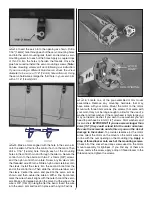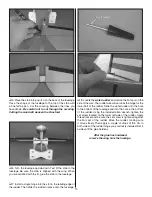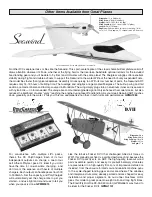
19
FLYING
The PBY Catalina is a great-fl ying model that fl ies smoothly
and predictably. The PBY Catalina does not, however,
possess the self-recovery characteristics of a primary R/C
trainer and should be fl own only by experienced R/C pilots.
CAUTION
(THIS APPLIES TO ALL R/C AIRPLANES): If,
while fl ying, you notice an alarming or unusual sound such as
a low-pitched "buzz," this may indicate control surface fl utter.
Flutter occurs when a control surface (such as an aileron or
elevator) or a fl ying surface (such as a wing or stab) rapidly
vibrates up and down (thus causing the noise). In extreme
cases, if not detected immediately, fl utter can actually cause
the control surface to detach or the fl ying surface to fail, thus
causing loss of control followed by an impending crash. The
best thing to do when fl utter is detected is to slow the model
immediately
by reducing power, then land as soon as safely
possible. Identify which surface fl uttered (so the problem
may be resolved) by checking all the servo grommets for
deterioration or signs of vibration. Make certain all pushrod
linkages are secure and free of play. If it fl uttered once, under
similar circumstances it will probably fl utter again unless the
problem is fi xed. Some things which can cause fl utter are;
Excessive hinge gap; Not mounting control horns solidly; Poor
fi t of clevis pin in horn; Side-play of wire pushrods caused
by large bends; Excessive free play in servo gears; Insecure
servo mounting; and one of the most prevalent causes of
fl utter; Flying an over-powered model at excessive speeds.
Takeoff
Before placing the airplane in the water for takeoff, be sure you
have plugged in the battery, armed the motors and performed
a range check of the radio system.
Make sure the rubber
plug is secured in the fuselage.
With everything in proper
working condition, place the airplane into the water. Taxi the
plane to get a feel for the handling. You will fi nd the plane taxis
well but when you begin the high speed takeoff run you need
to have a light touch on the rudder. Over controlling with the
rudder could result in a ground loop. When you are at high
speed on the water be prepared to control the wing with the
ailerons, keeping the wings level and not digging in a tip fl oat.
Remember to takeoff directly into the wind. As the model
gains speed the airplane will get up on the step and become
light on the water. Be smooth on the elevator stick, allowing
the model to establish a
gentle
climb to a safe altitude before
turning into the traffi c pattern.
Flight
For reassurance and to keep an eye on other traffi c, it is a
good idea to have an assistant on the fl ight line with you. Tell
him to remind you to throttle back once the plane gets to a
comfortable altitude. While full throttle is usually desirable for
takeoff, this model fl ies more smoothly at reduced speeds.
Take it easy with the PBY Catalina for the fi rst few fl ights,
gradually getting acquainted with it as you gain confi dence.
Adjust the trims to maintain straight and level fl ight. After
fl ying around for a while, and while still at a safe altitude
with plenty of fuel, practice slow fl ight and execute practice
landing approaches by reducing the throttle to see how
the model handles at slower speeds. Add power to see
how she climbs as well. Continue to fl y around, executing
various maneuvers and making mental notes (or having your
assistant write them down) of what trim or C.G. changes may
be required to fi ne tune the model so it fl ies the way you like.
Be aware of the time spent in the air, making sure you have
enough battery to land and taxi back. Use this fi rst fl ight to
become familiar with your model before landing.
Landing
To initiate a landing approach, lower the throttle while on the
downwind leg. Allow the nose of the model to pitch downward
to gradually bleed off altitude. Continue to lose altitude, but
maintain airspeed by keeping the nose down as you turn onto
the crosswind leg. Make your fi nal turn toward the runway/
water (into the wind) keeping the nose down to maintain
airspeed and control. Level the attitude when the model
reaches a couple of feet from the water, modulating the throttle
as necessary to maintain your glide path and airspeed. If you
are going to overshoot, smoothly advance the throttle (always
ready on the right rudder to counteract torque) and climb out
to make another attempt. When you’re ready to make your
landing fl are when the model is a foot or so off the water,
smoothly increase up elevator until it gently touches down.
One fi nal note about fl ying your model. Have a goal or fl ight
plan in mind for
every
fl ight. This can be learning a new
maneuver(s), improving a maneuver(s) you already know,
or learning how the model behaves in certain conditions
(such as on high or low rates). This is not necessarily to
improve your skills (
though it is never a bad idea!
), but more
importantly so you do not surprise yourself by impulsively
attempting a maneuver and suddenly fi nding that you’ve run
out of time, altitude or airspeed. Every maneuver should be
deliberate, not impulsive. For example, if you’re going to do a
loop, check your altitude, mind the wind direction (anticipating
rudder corrections that will be required to maintain heading),
remember to throttle back at the top, and make certain you
are on the desired rates (high/low rates). A fl ight plan greatly
reduces the chances of crashing your model just because of
poor planning and impulsive moves.
Remember to think.
Have a ball!
But always stay in control and fl y in a safe manner.
GOOD LUCK AND GREAT FLYING!


































